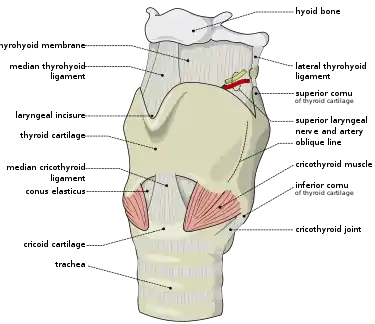Cricothyroid joint
The cricothyroid joint (or articulation) is a joint connecting the cricoid cartilage and the thyroid cartilage. It plays a key role in adjusting human voice pitch by changing the tension of the vocal cords. This tension is controlled mostly by the endolaryngeal vocalis and the extralaryngeal cricothyroid muscles which change vocal fold tension by narrowing the cricothyroid space created by rotation and gliding movements in horizontal and vertical direction allowed for by the cricothyroid articulation.[1]
| Cricothyroid joint | |
|---|---|
 The cartilages of the larynx | |
| Details | |
| Identifiers | |
| Latin | Articulatio cricothyreoidea |
| TA98 | A06.2.03.006 |
| TA2 | 1665 |
| FMA | 55101 |
| Anatomical terminology | |
Types
Three types A, B, and C have been identified.[1]
Type A is found in 56% of females and 66% of males. There is a well-defined "facet". It has a tight capsule and ligaments with either a concavity or a small groin directed from posterior superior to anterior inferior. Horizontal translational movement is about 3.0 mm, vertical gliding about 2.5 mm with great movement horizontally than vertically. The gliding movements are smaller in males than in females.
Type B is in 24% of females and 20% of males. In contrary to type A it lacks a definite "facet" and the two cartilaginous parts of the articulation are joined only by soft connective tissue. Horizontal movement is 5.0 mm and vertical, 5.1 mm with no differences between them.
Type C concerns all others and has a flat surface with or without a tiny protuberance. Horizontal movement is about 5.1 mm, and vertical 3.8 mm.
Type A is less mobile than the other two.[1]
References
- Hammer GP, Windisch G, Prodinger PM, Anderhuber F, Friedrich G. (2010). The Cricothyroid Joint-Functional Aspects With Regard to Different Types of Its Structure. J Voice. Mar;24:140-145. PMID 19185450
External links
- lesson11 at The Anatomy Lesson by Wesley Norman (Georgetown University) (larynxskel2)